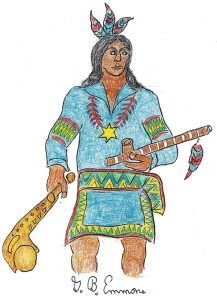King Philip was the second oldest son of the Wampanoag Sachem Massasoit who welcomed the pilgrims to Plymouth and helped them survive. The earthly relationship bore fruition the following fall by a feast of mutual friendship called Thanksgiving to which Massasoit brought 90 others from his Pokanoket village near today’s Bristol, Rhode Island.
In 1656, Massasoit had the Indian names of both his sons changed by the royal court at Plymouth to more prestigious English titles; the older boy, Wamsutta, became Alexander, and Metacomet became Philip.
When Massasoit died in 1661, Alexander became Sachem (leader), but died soon after from suspicious food poisoning while in English custody waiting to be questioned about rumors of an impending Indian uprising. When Philip became king, colonial population had grown to more than 40,000, creating a crowded conflict over land purchases. Philip said he did not want to start a war, and my illustration shows him with a peace pipe in one hand and his war club in the other, drawn from the actual weapon in a museum in Concord.
In June of 1675, the inevitable war started near the Pokanoket village, a location now known as the Town of Swansea, which was burned to the ground. Hostilities spread like wildfire all along the south shore settlements, destroying homes in today’s townships of Dartmouth, Fairhaven, Mattapoisett, Marion, Wareham, and Middletown.
Settler Hugh Cole had purchased most of the land in Mattapoisett from Philip, and Cole’s two sons were among the first to be captured; however, Philip released them, instructing them to tell their father to leave the area before his house was burned. In Fairhaven, John Cooke, who had come across the pond on the Mayflower, had built a fortified garrison at the head of Sconticut Neck for protection, but that also was burned. In what is now Wareham, blacksmith Uriah Leonard had supplied iron works and repaired guns for Philip, and when Indians came to burn his house, he was allowed to escape with his life.
All these settlements were joined by roads of old Indian trails, and natives were skilled at ambushes of frontier skirmishes that eventually expanded to 1,200 homes in 50 settlements all over New England. Indians intended to drive the English back into the sea. Fortunately for the early settlers – and ultimately us – some friendly Indian tribes like the Mohegans joined the English cause of survival.
Philip eventually fled to the Mohawks in New York for help, but they were already friends of the British. They attacked and killed almost all of Philip’s warriors, leaving him to limp back here, only to be shot by another Indian. Philip’s wife, seven-year-old son, as well as Philip’s sister, Amie, were all sold into West Indies slavery, a fate for many Indian survivors, with the proceeds helping to pay for the war. Soldiers that had fought in the war were granted parcels of Indian land to reward their service.
Although peace then came to residents of the south shore, the conflict continued into Maine and New Hampshire. This classic clash between old world and new world cultures actually began in the seventeenth century against Montezuma in Central America by Spanish conquistadores. And then it was followed by the invasion of New York by the Dutch and then English colonists, and finally the more conducive French missionaries. Casualties of both sides continued in battles more like massacres to darken American history, like Tippecanoe, the Cherokee trail of tears, Custer’s last stand at the Little Big Horn, and the Sioux Wounded Knee massacre.
With this trail of perspective by historians, Philip has come to be reconsidered as a patriot attached to his native soil, and compared to military leaders such as Macedon, Napoleon, and Washington. His redemption today may be our environmental awareness that mirrors his Native American belief of land value. And when we bow our heads for a bountiful Earthly harvest at the next Thanksgiving, let us do so in remembrance of his father, Massasoit, as well.
By George B. Emmons

I thought that I read somewhere that King Phillip was beheaded on his knees with a sword by the English..